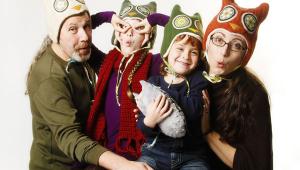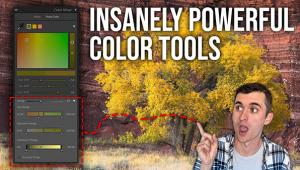What a great artistic photography. Your imagination and ideas are greatly to be obeyed. We must always try to plan for our growth by any means.
Building Business In The New Year: Start Making Plans For Growth



Shutterbug: Just to set the stage, is your photography client base consumer or commercial and will you continue this marketing direction into 2012?
Meg Baisden: Nearly 100 percent of our business is within the consumer market. We primarily focus on wedding photography, but we do offer a small amount of family portraiture and commercial photography. We are planning to maintain our current course for the 2012 season.
Lon Atkinson: Our client base is made up of commercial clients/corporations, catalogs, advertising agencies, and design studios. We are primarily product photographers and expect to continue in the direction that our studio is going and has gone for many years.
Marc Grauer: Our core business continues to focus on the corporate event photography market and we do not expect this to change for 2012. We have built a client base that includes working directly with corporate meeting and event planners, third-party planners, and incentive travel companies.
Tracey Clark: Both, and then some! I work with consumers and magazine editors and then, sometimes, clients for my work appear seemingly out of the blue. There’s really no telling and that is what I love about my business today. Years ago after experiencing major burnout, I let go of what I thought my photography business was “supposed to” look like and let my true creative passions pave the way. It’s taken some time to build since I used a very basic and grassroots approach to growing my body of work, but it really has paid off. And the best part is that I really love what I am doing with my photography now. With each new client I work with I understand how vast the market is for photographers. The sky is the limit.



SB: When you are looking at your overall marketing efforts, what are your plans for the new year—using the traditional marketing tools (direct mail, ads) or new online marketing tools (websites, e-mail blasts, blogs, Facebook) or both?
Lon Atkinson: Our marketing efforts are based on our website. Driving people to that website is our primary goal with any marketing that we do. We do e-mail blasts four times a year. We position ourselves to rate high on Google searches and use several domain names to drive people to our primary website.
Meg Baisden: We no longer buy any print advertising; all of our advertising efforts have shifted to a web-based platform. We advertise through Google AdWords, Facebook, and we pay for a variety of listings in directories, and on blogs. We do still use an e-mail newsletter for internal communications between our studio and past clients.
Tracey Clark: I credit the last five plus years of my career successes to the Internet. If it weren’t for starting my blog, getting really involved in social media, then founding www.shuttersisters.com, I have no idea what my career wouldlook like right now. Through it all, I have found that engaging with like-minded and like-hearted communities has really helped to cultivate and sustain my photography career. The relationships I have established online through blogging only make my creative work that much more meaningful and enjoyable.
Marc Grauer: We do not advertise in the traditional sense; however, we do use e-mail blasts about once a year to refresh our contact base. We are using Facebook to showcase some of our work directly to business friends and use this conservatively to update our current programs we believe will be of interest. Most of our marketing is focused on sponsorships or partnerships of events that include qualified meeting and event planners and buyers. Spending three to four days on-site with clients is more valuable to us and provides quality networking and the ability to showcase our services.
Also, as a program enhancement, we have developed a private website set up for planners to assist with their internal proposals, providing examples of photos and descriptions. What we are doing goes beyond just taking photos of guests at events. The web hosting allows guests to interact, share, and be social with the images we take. Guests can enjoy the photos well beyond the event and the client can use the site and images to further promote new events and future programs. We have had over 2 million hits to our galleries, all at no cost to guests and no cost to clients.



SB: How many different online marketing or portfolio formats are you using right now?
Lon Atkinson: Our main portfolio is our website. We often will put up special pages for a specific client who we are marketing to or are in negotiations with. We also have our mini portfolios. One is literally a miniature portfolio. It is made up of a small case with a dozen business card-size photos. Everyone who works here has them with them to hand out to any potential client. We also have a slide show on Zip drives that we will leave with perspective clients we have called on.
Meg Baisden: We use a website, a blog, and a digital information packet as our primary marketing tools. Occasionally, we are asked to meet in person, in which case we use a printed album sample.
Marc Grauer: We believe our photo web hosting site, www.siiphotos.com, provides a true look at what we provide in a “real time” environment and we have examples of events and programs that are relevant. We can direct clients to galleries and events that will give them an accurate look at our products and services. We have also used the print books as marketing tools.
Tracey Clark: I use blogs to showcase my work. It feels authentic for me and it keeps things fresh and current. Plus, it’s one reason my photography often goes hand in hand with my writing. And that makes my work unique. Traditionally, photographers and writers have been exclusive of one another but it’s not like that anymore. Now, if you can write and shoot (or even offer an image bank for licensing with your writing) you’re as good as gold for some clients! I’m also up for trying new things and taking creative risks with clients looking to dip their toes in experimental projects. I know my clients appreciate my willingness to work with them instead of for them. Plus, it usually makes it a lot more fun for both parties.
SB: What kind of frequency of contact with potential clients vs. with current clients do you find works best for your marketing?
Meg Baisden: We contact our clients an average of two times per year with correspondence not directly related to their event (studio announcements, for example). Facebook is a great tool for other general announcements and sharing information.
Lon Atkinson: We market to our existing clients, potential clients we have spoken with in the past two years, and potential clients we would like to meet with on a quarterly basis.
Tracey Clark: Because I have been so active online for so many years now and have established myself within many creative circles, people discover either my stories or my photography (or both) as they search the web. Many of the e-mails I receive start with, “I have followed your blog for years and love your work…” and end with a request for collaboration or images to license or editorial work (both my writing and my photography). It’s a testament to putting yourself and your work out there. Plus, when people find you this way, they really want you. They aren’t just looking for any photographer. And that is exactly the kind of client I want to work with.
Marc Grauer: Once a program is confirmed, we are in regular contact with clients prior to their events or programs to work through logistics, designs, and operations. Our potential clients are generally clients we have met or have been referred to us. This stage of marketing may include a site or office visit, customized proposals for their specific programs, and a collaborative effort to meet and exceed what they may have done in the past relative to “event photography.”
SB: What advice do you have for those just starting out—or restarting their business—to avoid pitfalls and pursue opportunities?
Lon Atkinson: I think one of the biggest mistakes people make is marketing a talent or style that they cannot produce. Another is not being aware of what a potential client does or how they use photography. I spoke with an art director of a good size specialty ad agency recently. He told me he gets five to 10 e-mails a day from photographers looking for work. He could not understand why they would send samples of bad photography or samples of work that has nothing to do with what they use. I left his office with a nice job for a product shoot. I would also say to new photography marketers: be prepared. Have several different portfolios ready to put up on your website or send to a potential client. If a client needs architectural photography, don’t send him photos of products. Target your portfolios.
Marc Grauer: Focus on what you do best and continually refine that element. We saw an opening with a certain element of corporate event photography that most general photographers did not want to pursue due to the investment in equipment and the travel required. Many of our clients have in-house production and photographers and still use our services.
Tracey Clark: There are no real shortcuts. I talk to people all the time who want to know how to get up to speed on all of these things: making connections, getting engaged in social media, becoming authorities in their field. The truth is, for as much as you can read about it or get advice, you really have to commit to your art and put in the time and energy it takes to establish yourself. Becoming an expert in my specific genre of photography has taken the investment of time and I have had to be patient. There’s no way around that. I have heard a lot of photographers talk about the evils of the medium’s accessibility and how the competition in the marketplace makes it that much harder to find work as a photographer. I combat that way of thinking by making it my job to find the niche no one else has filled or can fill. It’s not only a challenge I like to take on, it’s really exciting when I find something that works. You can’t be afraid of reinvention. I feel like I’m reinventing my career all the time. It’s the only way to keep up with the speed of the field. Plus, it’s exciting!
Online References
Atkinson! Studios
• www.atkinsonstudios.com
• http://blog.atkinsonstudios.com/
Meg Baisden Photography
• www.megphoto.com
• www.megphoto.com/blog
• www.facebook.com/charles.baisden
• www.facebook.com/meg.baisden
• www.facebook.com/pages/Meg-Baisden-Photography/9084958666
Tracey Clark
• www.traceyclark.com
• Twitter: @traceyclark
• www.shuttersisters.com
• Twitter: @ShutterSisters
• www.facebook.com/shuttersisters
• Expressive Photography: The Shutter Sisters’ Guide to Shooting from the Heart, www.amazon.com
Marc Grauer, Specialty Imaging International
• www.specialty-imaging.com
• www.siiphotos.com
• www.facebook.com/pages/Specialty-Imaging-International/115587745163250?sk=wall
- Log in or register to post comments


Trading zone where you can do entire trading, online buy and online sell , us trade | Many people extract lot of experience during this online buying | online selling platform, many other think about this is a foreign exchange | center, but it is wrong because it is a uk trade Like Presented by: seo learning

Planning business events once a year can also boost your success, a good event could make more people notice what you've got to offer. If you really want your party to be the talk of the year you should know that determining the right speaker for your event is a must, if planned correctly you have nothing to worry about.
















































